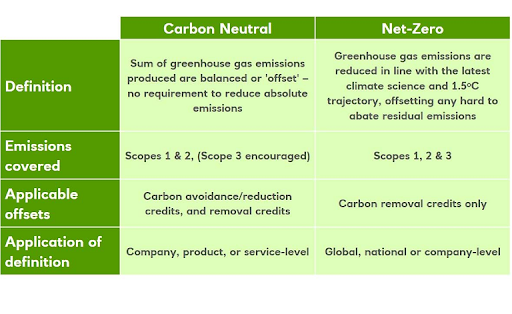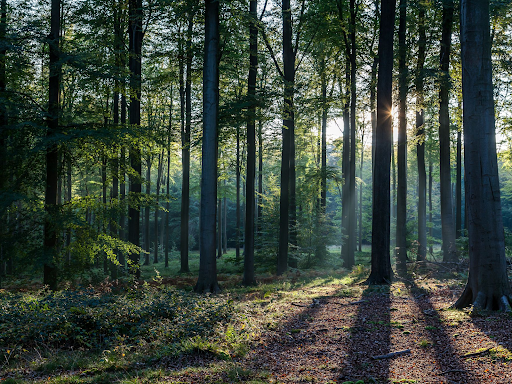As more and more companies, nations, and organizations work to reduce their carbon dioxide emissions, they use a few different terms to describe their efforts. The diversity of phrases and lack of clarity can sometimes be misleading. So what do these different terms mean? And how can the goals behind them be achieved?


 A carbon sink is a system that absorbs more carbon than it emits, and the primary natural carbon sinks are forests, oceans, and soil. According to the European Parliament, natural sinks remove between 9.5 and 11 Gt of CO2 per year. The carbon stored in natural sinks like forests are released into the atmosphere through changes in land use, logging, and forest fires. So often, for example, carbon offsets will be money spent to protect a forest from being cut down that otherwise would have been. It is important to ensure that the offsets you purchase are verified and of good quality, ideally with co-benefits for nature and communities in areas where they are generated, so you can make sure your offsets are truly removing as much carbon as they claim. They need to be verified from a trusted source, transparent about their methodology, and effective at sequestering carbon. The Verified Carbon Standard (VCS) is the largest voluntary GHG program under which such carbon credits can be certified.
A carbon sink is a system that absorbs more carbon than it emits, and the primary natural carbon sinks are forests, oceans, and soil. According to the European Parliament, natural sinks remove between 9.5 and 11 Gt of CO2 per year. The carbon stored in natural sinks like forests are released into the atmosphere through changes in land use, logging, and forest fires. So often, for example, carbon offsets will be money spent to protect a forest from being cut down that otherwise would have been. It is important to ensure that the offsets you purchase are verified and of good quality, ideally with co-benefits for nature and communities in areas where they are generated, so you can make sure your offsets are truly removing as much carbon as they claim. They need to be verified from a trusted source, transparent about their methodology, and effective at sequestering carbon. The Verified Carbon Standard (VCS) is the largest voluntary GHG program under which such carbon credits can be certified.
Carbon Neutral & Net-Zero
Carbon neutral means that any CO2 released into the atmosphere from a company or organization’s activities is balanced by an equivalent amount being removed. Carbon neutrality means that you can compensate for your emissions (usually with offsets), but net-zero requires abatement of your emissions, meaning you have to actually get rid of them through efficiency, electrification, and renewable energy. For example, a company’s building running entirely on solar, and using zero fossil fuels can label itself as net-zero. However, when referring to “net-zero”, it is crucial to specify net-zero carbon or emissions, because net-zero emissions takes into consideration all greenhouse gasses, not just carbon dioxide. Most climate goals across the world are aiming for net-zero emissions by either 2030 or 2050.
Carbon Negative & Carbon Positive
Carbon negative means that activity goes beyond achieving carbon neutral to create an environmental benefit by removing additional carbon dioxide from the atmosphere. Carbon positive and carbon negative mean the same thing and they are interchangeable terms. So carbon positive also means removing more carbon dioxide from the atmosphere than is generated. Different companies use different terms, and most likely the term carbon positive was introduced because it has a more positive connotation. Microsoft has announced that they will be carbon negative by 2030 and there are a number of other companies working towards the same goal.Emissions Reductions
The first step that companies should take in reducing their emissions is to calculate their carbon footprint so they have a better sense of how much their company needs to counteract. The next step is to determine where the company emits the most carbon dioxide and then take action to reduce emissions. Companies and organizations should seriously consider switching their energy source from fossil fuels to renewable resources like solar and wind. Another option companies can explore to reduce their emissions is to review their supply chain to find suppliers and logistics that create less emissions.
Emissions Offsets
In order to become carbon negative, as well as to support actions towards becoming climate neutral, companies must invest in carbon offsets, or carbon credits. One credit usually equals 1 metric ton of carbon removed from the atmosphere. Carbon offsets prevent carbon from being emitted through alternate practices and then measure the amount and put it in the form of carbon credits that can be purchased. Another method is to remove carbon from the air in the form of carbon sequestration, but this technology is still in its infancy and isn’t effective on a large scale yet. A carbon sink is a system that absorbs more carbon than it emits, and the primary natural carbon sinks are forests, oceans, and soil. According to the European Parliament, natural sinks remove between 9.5 and 11 Gt of CO2 per year. The carbon stored in natural sinks like forests are released into the atmosphere through changes in land use, logging, and forest fires. So often, for example, carbon offsets will be money spent to protect a forest from being cut down that otherwise would have been. It is important to ensure that the offsets you purchase are verified and of good quality, ideally with co-benefits for nature and communities in areas where they are generated, so you can make sure your offsets are truly removing as much carbon as they claim. They need to be verified from a trusted source, transparent about their methodology, and effective at sequestering carbon. The Verified Carbon Standard (VCS) is the largest voluntary GHG program under which such carbon credits can be certified.
A carbon sink is a system that absorbs more carbon than it emits, and the primary natural carbon sinks are forests, oceans, and soil. According to the European Parliament, natural sinks remove between 9.5 and 11 Gt of CO2 per year. The carbon stored in natural sinks like forests are released into the atmosphere through changes in land use, logging, and forest fires. So often, for example, carbon offsets will be money spent to protect a forest from being cut down that otherwise would have been. It is important to ensure that the offsets you purchase are verified and of good quality, ideally with co-benefits for nature and communities in areas where they are generated, so you can make sure your offsets are truly removing as much carbon as they claim. They need to be verified from a trusted source, transparent about their methodology, and effective at sequestering carbon. The Verified Carbon Standard (VCS) is the largest voluntary GHG program under which such carbon credits can be certified.


Add a Comment
You must be logged in to post a comment